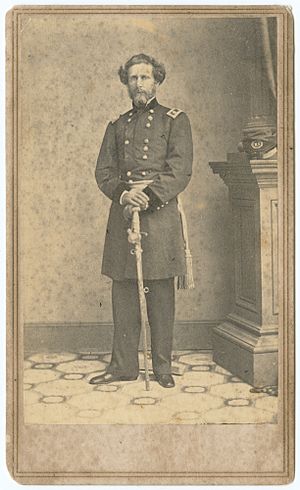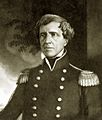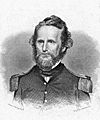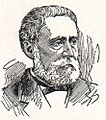John C. Frémont facts for kids
Quick facts for kids
John C. Frémont
|
|
|---|---|
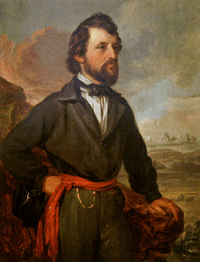
John C. Frémont, 1852 portrait, by William S. Jewett
|
|
| 5th Territorial Governor of Arizona | |
| In office October 6, 1878 – October 11, 1881 |
|
| Appointed by | Rutherford B. Hayes |
| Preceded by | John Philo Hoyt |
| Succeeded by | Frederick Augustus Tritle |
| United States Senator from California |
|
| In office September 9, 1850 – March 3, 1851 |
|
| Preceded by | None (Statehood) |
| Succeeded by | John B. Weller |
| 3rd Military Governor of California | |
| In office January 14, 1847 – March 1, 1847 |
|
| Appointed by | James K. Polk |
| Preceded by | Robert F. Stockton |
| Succeeded by | Stephen W. Kearny |
| Personal details | |
| Born |
John Charles Fremon
January 21, 1813 Savannah, Georgia, U.S. |
| Died | July 13, 1890 (aged 77) New York City, U.S. |
| Political party | Republican |
| Spouse | Jessie Benton |
| Alma mater | College of Charleston |
| Profession | Soldier |
| Signature | |
| Military service | |
| Branch/service | United States Army |
| Years of service | 1838–1848 1861–1864 |
| Rank | Major General |
| Commands | California Battalion Department of the West |
John Charles Frémont (January 21, 1813 – July 13, 1890) was an American explorer, soldier, and politician. He was a U.S. Senator for California. Frémont was also the first person nominated for president by the Republican Party in 1856. He helped start the California Republican Party. He lost the election to James Buchanan.
Frémont helped lead many surveying trips across the western United States. In 1838 and 1839, he explored lands between the Mississippi River and Missouri River. In 1841, he mapped parts of the Des Moines River. From 1841 to 1846, he led groups on the Oregon Trail and into the Sierra Nevada mountains.
Contents
John C. Frémont's Early Life and Education
John Charles Frémont was born on January 21, 1813. His father, Charles Frémon, was a teacher from French Canada. His mother, Anne Beverley Whiting, came from a well-known family in Virginia.

Frémont's father died in 1818. This left his mother to raise John and his siblings with little money. They moved to Charleston, South Carolina. Frémont grew up proud and determined. He wanted to prove himself.
A lawyer named John W. Mitchell helped Frémont get an early education. In May 1829, Frémont started at Charleston College. He also taught in the countryside. He was asked to leave the college in 1831 because he didn't attend regularly. However, he had learned a lot about math and science.
Frémont caught the eye of Joel Roberts Poinsett, a powerful politician from South Carolina. Poinsett helped Frémont get a job teaching math on the ship USS Natchez in 1833. Frémont sailed in South American seas.
Frémont later left the navy. He became a second lieutenant in the U.S. Topographical Corps. He helped survey a route for a railroad. While working in the Carolina mountains, Frémont dreamed of becoming an explorer.
His desire to explore grew between 1837 and 1838. He was in Georgia, preparing for the removal of Cherokee Indians. When Poinsett became Secretary of War, he helped Frémont. Frémont then assisted Joseph Nicollet, a famous French explorer. They explored lands between the Mississippi and Missouri rivers. Frémont became an excellent mapmaker. He learned about astronomy and geology. He also described plants, animals, soil, and water.
Frémont's Important Explorations

The exploration of the American West began in 1804. The Lewis and Clark Expedition explored the new Louisiana Purchase territory. They searched for a route to the Pacific Ocean. President Thomas Jefferson also sent the Pike Expedition to explore the southwest.
American and European fur trappers explored much of the West in the 1820s. Frémont, known as The Pathfinder, continued this work. He built on what earlier explorers had done. He helped expand knowledge of the American West.
Frémont's special skill was his scientific reports and maps. He published these based on his trips. His wife, Jessie, helped him write them. Their exciting writing style encouraged many Americans to travel West. From his findings, seven maps were made and published in 1846. These maps showed the entire Oregon Trail. They guided thousands of American settlers.
Starting in 1842, Frémont led five expeditions to the West. However, between his third and fourth trips, his career changed. This was because of the Mexican–American War.
Frémont's Career in Politics and Military
On January 16, 1847, Frémont became Governor of the new California Territory. This happened after the Treaty of Cahuenga, which ended the Mexican–American War in California. He served as a Senator from California for a short time (from 1850 to 1851).
In 1856, the new Republican Party chose him as their first candidate for president. But he lost the election to James Buchanan.
Frémont served as a major general in the American Civil War. He declared martial law in Missouri. This caused a disagreement with President Abraham Lincoln. Frémont was removed from his command in the West on November 2, 1861. He was given a different job in West Virginia. But he lost several battles and then resigned.
After the Civil War, Frémont lost much of his money. He had invested a lot in an unsuccessful railroad in 1866. He lost more money during the Panic of 1873. Frémont served as Governor of Arizona from 1878 to 1881. President Rutherford B. Hayes appointed him to this role.
Later Life and Death
On Sunday, July 13, 1890, John C. Frémont died at age 77. He passed away from an illness at his home in New York City. His death was unexpected.
He was first buried in Trinity Church Cemetery. Later, on March 17, 1891, he was reburied in Rockland Cemetery in Sparkill, New York.
After Frémont's death, his wife Jessie received a Civil War pension. This gave her an income of $2,000 per year.
Frémont's Legacy
Four states have counties named after him: Colorado, Idaho, Iowa, and Wyoming. Several cities are also named after him, like Fremont, California and Fremont, Nebraska.
Historians have different views of Frémont. Some see him as a military hero who achieved a lot. Frémont's published reports and maps were very important. They helped many Americans move West starting in the 1840s.
Images for kids
-
Thomas Hart Benton, a U.S. Senator, supported Frémont.
-
Frémont (seated right) and Kit Carson, his expedition guide.
-
Frémont was blamed for Nathaniel Lyon's Union defeat at Wilson's Creek.
-
A plaque at Henry Cowell Redwoods State Park where Frémont camped in 1846.
See also
 In Spanish: John C. Frémont para niños
In Spanish: John C. Frémont para niños


